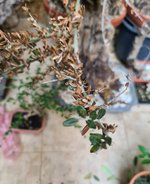I've dug quite a few olives. Over here they are becoming an environmental weed in places so freely available and we get a bit of practice without cost in case of failure.
Success rate of 100%. I thought one was not going to make it but after nearly a year it decided to perk up and produce new shoots.
Roots are cut really short at collection. In many cases there are almost no fine roots around the base of the tree so none to collect. Some of the older trees have grown a few smaller roots from the lignotuber which do give the transplant a head start but it seems that there is no need to try to collect and retain roots. Some club members just dig down to the widest part of the lignotuber and then saw the tree off with a chainsaw and plant the result 'flat bottom' tree as a giant cutting. Success is still good with this method.
Needless to say with so few roots it is almost impossible to retain field soil on the collected olives. In any case I don't like field soil in my pots so generally shake of as much soil as will easily drop away from ALL collected trees regardless of species. Even if a species has associated fungi, etc there will still be plenty on the soil adhering to roots to recolonize the new pot so retaining field soil is a myth in my opinion.
Removing field soil allows me to start the transplanted tree in the soil it will grow in for the future. All my transplants go directly into the same mix I use in all pots. That mix is designed to be the best I can manage for pot culture. I know how to maintain water and nutrients to trees potted in that mix. Why would I use some other mix that requires a changed care regime when this one is so good? Coarse sand has been mentioned and would probably be a second choice for recovering transplants but I would have to relearn watering, etc to maintain optimum moisture and nutrient levels so I'll stick to the standard mix until someone can prove that something like sand would be better. Note that 'sand' varies a lot in texture an particle size. What one person considers sand would be gravel to another or too fine for some. i would be interested to hear what characteristics the sand that
@BonjourBonsai uses has, especially particle size.
We have collected all year round down here with some minor differences in recovery but all have so far survived. Note our winter nights only just dip below freezing which may be a factor in seasonal differences in suitable time to collect species like olives. My preferred time of year is mid - late spring into early summer when most olive transplants seem to respond quickest.
Quick replanting does not seem to matter. Our trees are usually just piled into the back of an open tray truck for the drive home so roots may be exposed to the air for a few hours to half a day at least. I try to pot up reasonably soon but if I can't do so within a few hours I just dunk the bases into a tub of water until I can find the time.
There may be alternative approaches that work just as well but what I have been doing seems to work well here.






